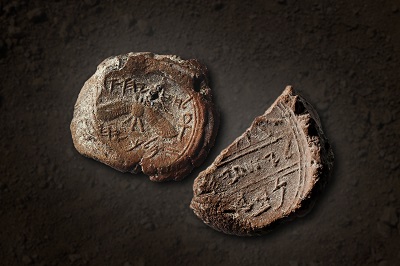The Yeshaya impression is at the right, and the Chizkiyahu Hamelech at the left.

The Prophet Isaiah may have created an 8th century BCE seal impression discovered in First Temple remains near the Har Habayis last year, according to Hebrew University archaeologist Dr. Eilat Mazar.
"We appear to have discovered a seal impression, which may have belonged to the prophet Isaiah, in a scientific, archaeological excavation," said Mazar last year, soon after the discovery was made.
Mazar's team uncovered the small bulla, or seal impression, during excavations at the Ophel, located at the foot of the southern wall of the Temple Mount in Jerusalem.
The clay impression is inscribed with letters and what appears to be a grazing doe, a motif of blessing and protection found in Judah, particularly in Jerusalem, according to archaeologists.
Key of the Yeshaya bulla

The oval-shaped bulla, however, is not intact. On its legible portion, there is an inscription with First Temple Hebrew letters that seem to spell out the word leYesha'yah[u],. On a line below, there is the partial word nvy, which may spell out "prophet."
"Because the bulla has been slightly damaged at the end of the word nvy, it is not known if it originally ended with the Hebrew letter alef, which would have resulted in the Hebrew word for 'prophet' and would have definitively identified the seal as the signature of the prophet Isaiah," Mazar said.
"Without an alef at the end, the word nvy is most likely just a personal name," she concluded.
The Isaiah bulla was discovered in wet-sifted material that was taken from an Iron Age layer close to bedrock that was near a foundation trench cut for a wall of a Herodian vault. The material was found close to a structure that was first discovered in 1986-87 and is today thought to have been a royal bakery.
It was found only 10 feet away from where in 2015 Mazar's team discovered an important, intact bulla with the inscription "of King Hezekiah of Judah."
Digging in 2005-2008 in a large structure which may have been the palace of King David, she discovered a clay impression with a First Temple Hebrew inscription bearing the name of a high-ranking Israelite official who is recorded by Jeremiah, "Jehucal, son of Shelemiah, son of Shovi." Years later, a few meters from the Jehucal bulla, she found a seal impression belonging to a second high-ranking official, "Gedaliah, son of Pashur," who is also found in Jeremiah.




